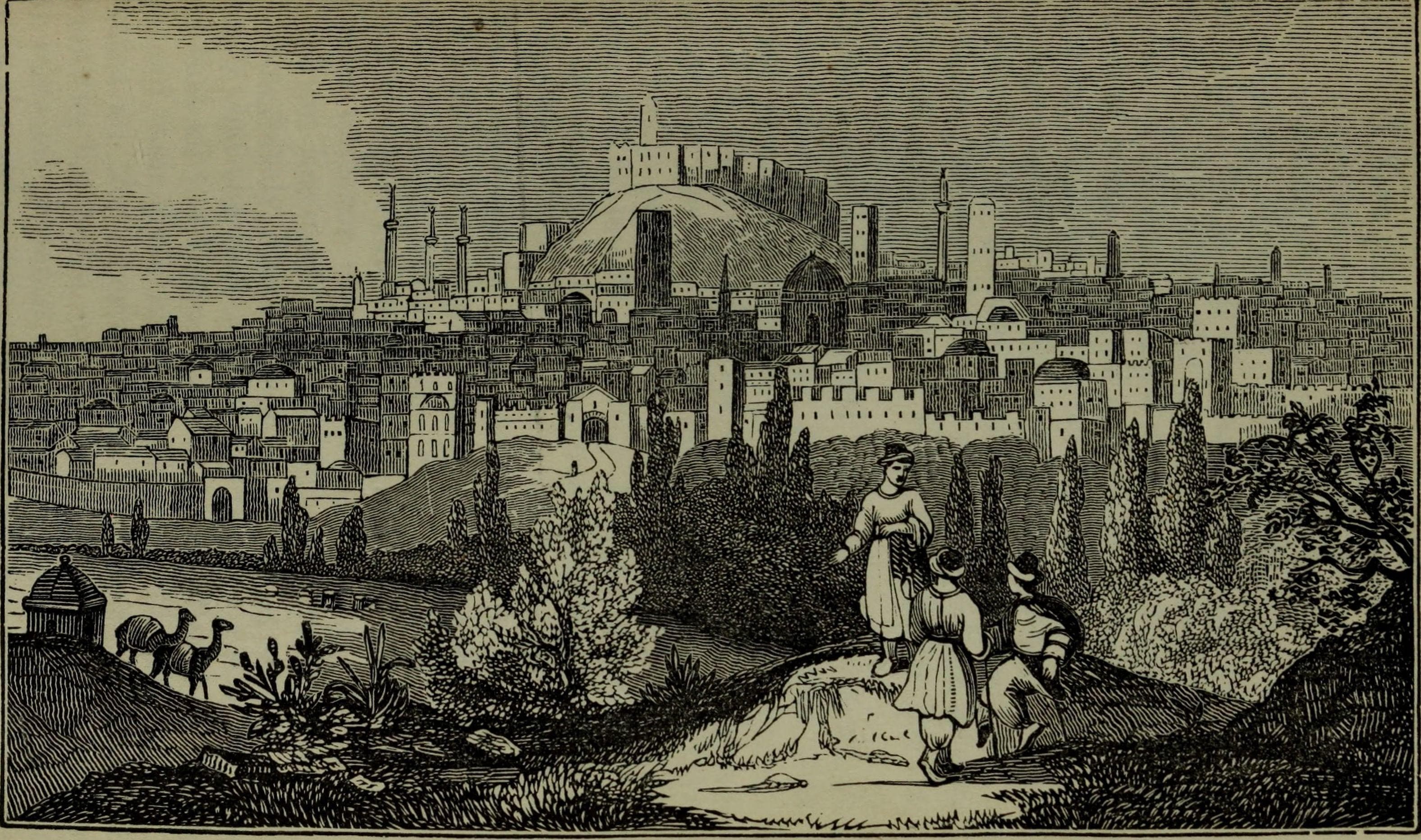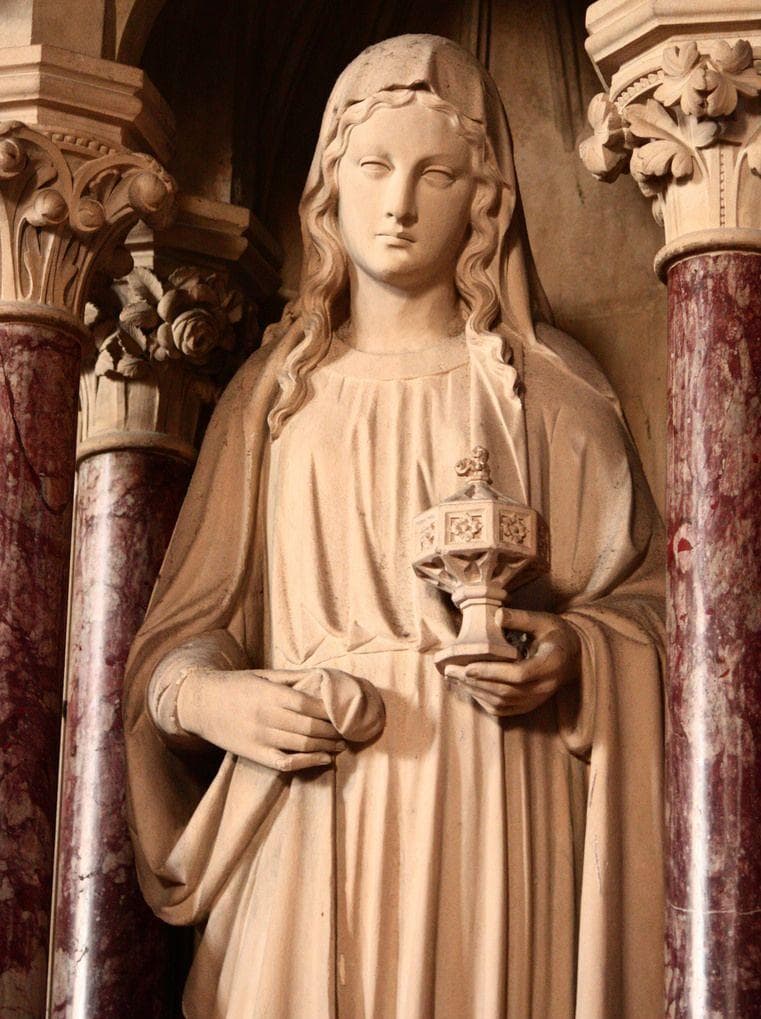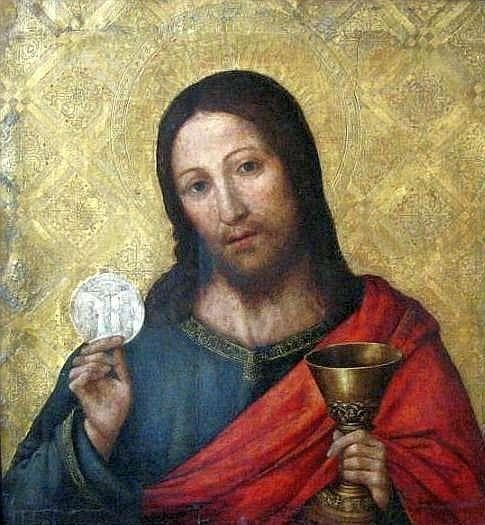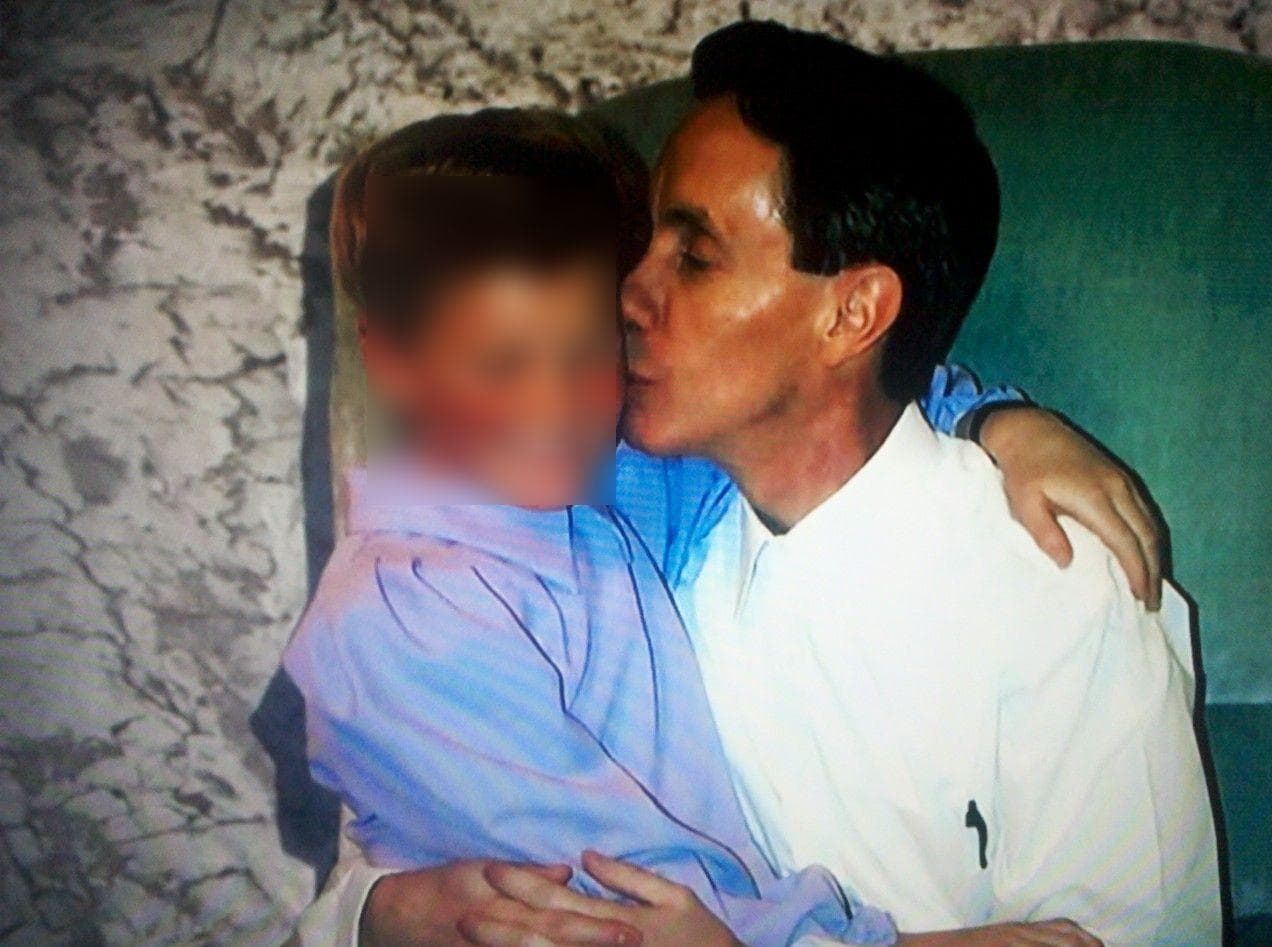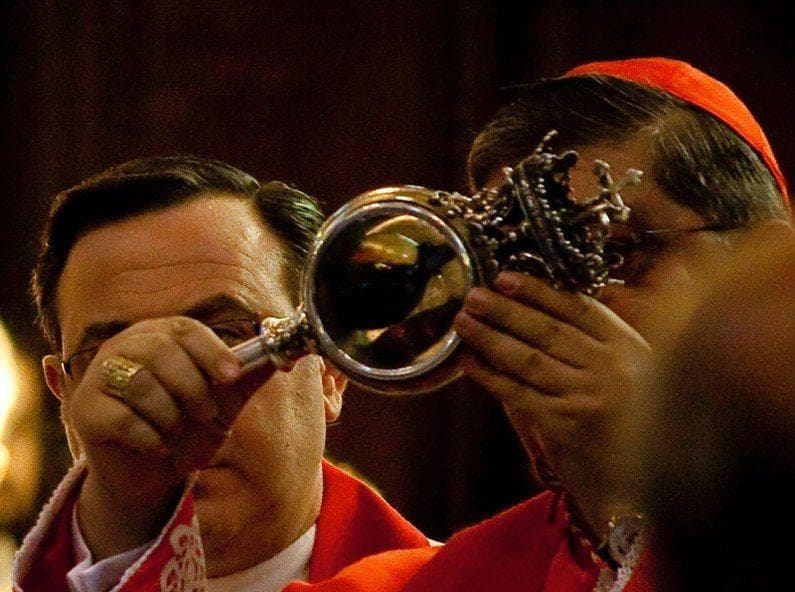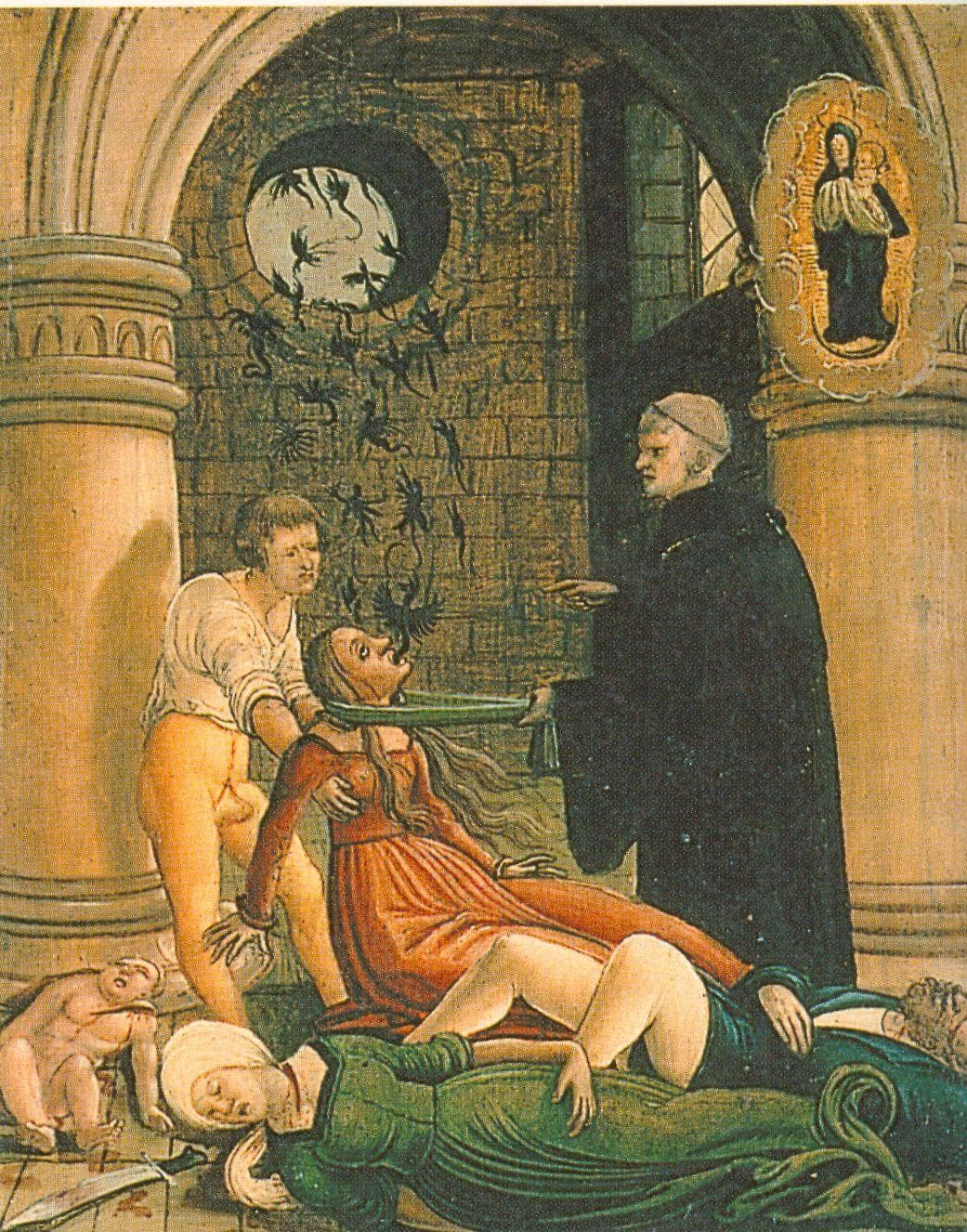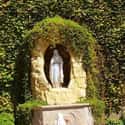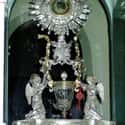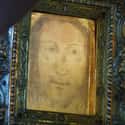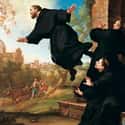-
(#1) The 1917 Miracle Of The Sun
In May 1917, children returning home from shepherding reportedly encountered an apparition of the Virgin Mary in Fátima, Portugal. She allegedly told the children of her plans to appear on the 13th day of the next six months, prompting the kids to rush home and tell their parents of their vision. People hoping to see the Virgin Mary at the appointed times gathered in Fátima to watch a miracle.
On October 13, 1917, the Virgin Mary supposedly appeared only to the children - and predicted the end of World War I. As the story goes, she then presented the 70,000 in attendance with a silver sun to clear the stormy skies, as described by the Lisbon paper O Dia:
The silver sun... was seen to whirl and turn in the circle of broken clouds. A cry went up from every mouth and the people fell on their knees on the muddy ground... The light turned a beautiful blue as if it had come through the stained-glass windows of a cathedral and spread itself over the people who knelt with outstretched hands. The blue faded slowly and then the light seemed to pass through yellow glass... People wept and prayed with uncovered heads in the presence of the miracle they had awaited. The seconds seemed like hours, so vivid were they.
Nonbelievers and believers alike provided eyewitness accounts for daily newspapers across Portugal, corroborating the movement of the sun. Some theories suggest the event was a mass hallucination brought on by fervor and the need to see something unexplainable.
-
(#2) Incorruptible Bodies Of Saints That Never Decay
In the early 20th century, saints known as "incorrupt" were discovered with preserved bodies. Some of these saints decomposed after their final resting places became unsealed, allowing everyday microbes and contaminants to end their time of untouched perfection. Still, believers in the miracle of incorrupt saints stay undeterred in their faith, feeling assured that God blessed his servants with bodies that remained in pristine condition after death - even though the Catholic Church eventually stopped declaring these to be miracles.
Coinciding with the Church's decision were the scientific discoveries that most of the saints underwent a mummification process as part of their preparation for burial. Other saints, meanwhile, had the luck of being kept in chilled vaults that staved off decay.
But a number of saints were scientifically proven to have no special conditions in their final resting place, nor any preparation to preserve them after burial. St. Zita received a full examination via intra-body camera by scientists working under pathologist Gino Fornaciari of the University of Pisa. They found no sign of post-mortem cuts or preservation methods on or in the corpse. At least three other saints - St. Ubald of Gubbio, Blessed Margaret of Savoy, and St. Savina Petrilli - are also inexplicably preserved.
-
(#3) Our Lady Of Lourdes And The Healing Water
In 1858, in Lourdes, France, a 14-year-old girl named Bernadette Soubirous lived with her family in an abandoned prison. Bernadette went with her sister and a friend to collect firewood on February 11. She lagged behind due to asthma and found herself alone at the Grotto of Massabielle, while the other girls had already crossed the cold stream.
According to Bernadette, as she worked to remove her socks and shoes, gusts of wind issued from the grotto before a blinding light followed. A woman in white robes with a blue sash, yellow roses on her feet, and a rosary in her hands appeared to Bernadette and encouraged her to pray. Bernadette's companions did not see any of this and brushed off her account of the vision.
She visited the woman daily over the next 15 days, despite police intervention and her parents' disapproval. On February 25, the woman told Bernadette to drink from and bathe herself in the fountain, but there wasn't one. The girl dug with her fingers until she found an underground water spring that still flows today. Three days later, the woman told the girl to build a church on the land, but the local clergy dismissed her until 1862 when they officially decreed the Virgin Mary had revealed herself.
Millions flock to the spring annually, and the Medical Bureau of the Sanctuary claims upward of 7,000 visitors have received healing from their ailments by immersing themselves in the spring. Each cured person submits their information to the Bureau for scientific authentication before leaving the holy grounds. Of the 7,000 reports of healing since 1862, 66 remain unexplained by science.
Bernadette became St. Bernadette after committing herself to a life of servitude as a nun and is one of the incorrupt saints recognized by the Catholic Church.
-
(#4) Our Lady Of Zeitoun
Between 1968 and 1971, millions of people claimed to see the illuminated Virgin Mary atop the St. Mary's Coptic Orthodox Church in Zeitoun, Egypt. One witness thought he saw a nun on the roof of the church and ran to intercept what he believed was a suicide attempt. Instead, the glowing woman disappeared. Over the next three years, the Virgin Mary reportedly appeared for minutes or hours to crowds of people gathered at the foot of the church. She was seen holding olive branches and with doves flying around her at night, or with St. Joseph and a baby Jesus on occasion.
Investigations by local police tried to debunk the miracle and disperse the crowds from the area. A search within a 15-mile radius of the church uncovered no special effects equipment, special lighting rigs, or projectors capable of putting on such a spectacle. Some theories include mass hysteria, with the gathered people seeing what they wanted or expected to see. Many of the assembled witnesses, though, were Muslim and had no reason to imagine a figure they don't consider highly significant to their religion.
Many religious scholars point to Mary's appearance as the fulfillment of a promise she made to the family who built the church. Around 1918, the Virgin Mary allegedly appeared to Ibrahim Khalil in a vision and told him to build the church in her name on the land. She promised to return to the location and bless the church in 50 years. The church was completed in 1924, and the Virgin Mary returned in 1968 to perform what is now considered the miracle of Zeitoun.
-
(#5) Consecrated Hosts That Survived Disaster
The consecrated hosts refer to the wafers used in Holy Eucharist. Catholics believe the wafers, along with the wine, turn into the actual body and blood of Christ during the priest's consecration of the items. The wafers reside in a tabernacle until retrieved for Holy Eucharist or other designated times outside of Mass.
Sixteen months after a 2016 earthquake in Italy, Father Angelo Ciancotti claimed he recovered 40 consecrated hosts from the Our Lady of the Assumption church. Ciancotti said he found the hosts' container had fallen in the quake, but the lid remained intact. He maintains the hosts showed no signs of mold or staleness about them after almost a year and a half of being locked in the rubble of the tabernacle.
The nuns who made the hosts confirmed nothing but flour and water was in the wafers.
-
(#6) The Weeping Statue Of Our Lady Of All Nations In Akita
The statue of Our Lady of All Nations in Akita, Japan, was carved from a Judea tree in 1963. The miracle attached to the figure relates to the deaf Sister Agnes Katsuko Sasagawa, who reportedly saw bright lights and angels near the statue's altar in June 1973. During prayer before the Virgin Mary statue, stigmata appeared on Sister Agnes's hands and recurred for three weeks. According to the story, Sister Agnes returned to the Statue of Our Lady of All Nations to pray and heard the Virgin Mary speak.
Sister Agnes continued praying in front of the statue, and it revealed its own stigmata in its carved hands. After this, the statue began to sweat a rose-scented liquid that the nuns of the order collected. In January 1975, the figure started weeping and did so on multiple occasions until September 1981 - with one such episode airing on television. Allegedly, not only was Sister Agnes cured of her deafness in 1982, but a visitor was also cured of her brain cancer in 1981 after praying in front of the statue.
The liquids the statue produced underwent scientific testing by three different researchers starting in 1975. The first, Professor Eiji Okuhara of Akita University, determined the samples were actual blood, sweat, and tears; the sweat and tears were type AB and the blood type B. The second test, performed by forensic scientist Dr. Kaoru Sagiska, gave the same results as those of Okuhara. A later examination revealed the fluids to be type A and AB and the blood type O, but the samples had allegedly become contaminated during handling over time.
-
(#7) St. Januarius's Annually Liquefying Blood
St. Januarius served as a bishop of Naples until his decapitation at the hands of Diocletian persecutors around the year 305. After his beheading, a woman allegedly collected blood from his body and placed it in a container. Eight years after his death, the first Blood Miracle of St. Januarius occurred. The Blood Miracle is still reported and was captured on video in 2015.
The miracle generally occurs three times a year, when the dried blood kept in its sealed container liquefies on the first Saturday of May, September 19, and December 16. When the blood fails to liquefy, the Catholic Church regards it as a warning about impending disasters. On various dates where it did not transform, it was linked to earthquakes, disease outbreaks, war, and the Nazi occupation in Italy.
The Church refuses to unseal the blood from its container, making it difficult for scientists to test. Despite this obstacle, researchers still theorize about possible explanations. One scientist suggests it's a material with a low melting point, which allows it to remain dry until removed from its altar and held by priests or subjected to a room with a large congregation or lit candles.
Spectrographic tests run on the vial contents in 1902 and 1989 supposedly revealed hemoglobin present inside, though it's possible for some dyes to present themselves as the blood protein.
-
(#8) The Miracle Of Lanciano
Referred to by many as the first Eucharistic Miracle of the Catholic Church, the miracle of Lanciano occurred in Italy during the 700s. A monk in the Church of St. Legontian wavered in his faith concerning the Catholic belief of transubstantiation - the process that turns wine and wafers into the blood and body of Christ during their consecration at the Sacrament of the Eucharist. As the monk spoke the words consecrating the wafers and wine, the food and drink allegedly turned into real human tissue and blood in front of witnesses at Mass. Throughout the following centuries, the blood and flesh remained unchanged in an ivory reliquary that traveled among different churches in Italy for display.
On March 4, 1971, Dr. Edoardo Linoli, former head of the Laboratory of Pathological Anatomy at the Hospital of Arezzo and professor of sciences, released his findings on the supposed blood and flesh held by the Catholic Church since the eighth century. He determined the flesh to be blood type AB and the tissue that of a human heart, specifically the endocardium. He found the blood to be consistent with that found on the hotly debated Shroud of Turin, and the tests revealed no preservatives in the samples.
A World Health Organization commission confirmed Linoli's findings after 500 experiments conducted over 15 months.
-
(#9) The Virgin Of Guadalupe
For three days in December 1531, the Virgin Mary supposedly appeared to Aztec Juan Diego during his trek through Mexico. Bathed in light, Mary came to him, explained her wish to have a church built where she was standing and asked Diego to take her message to the bishop. Diego did as she asked, traveling to the home of Fray Juan de Zumarraga, but he failed to convince the bishop. After a second visit with Mary and another attempt at getting the church built, the bishop asked Diego for proof of Mary's appearance.
On his third encounter with Mary, she instructed Diego to fill his tilma - a type of cloak - with roses cut from a snowy hillside where flowers normally did not grow in December. When Diego returned to the bishop and allowed the roses to fall from his tilma, a painting of the Virgin Mary appeared on the fabric, just as Diego had described to the bishop.
Skeptics theorized the Spanish fabricated the miracle to convert Aztecs to Catholicism, with the apparition's insistence of being called Santa Maria de Guadalupe. But the Spanish did not write of the miracle until 1548, and supposedly the influx of Aztecs converting began in 1531. The image of Santa Maria de Guadalupe has not degraded over the centuries; testing showed the garment was made of hemp, explaining its longevity.
A photographer named Alfonse Marcue claimed in 1929 that he noticed the reflection of a bearded man in the painting's right eye. In 1956, an ophthalmologist named Dr. Javier Torroella Bueno also believed there was a reflection in the painted eyes of Mary. Peruvian engineer José Tonsmann spent 20 years attempting to unlock the truth about the representation of the bearded man, claiming the supposed image "has not been painted by human hand."
-
(#10) The Shroud Of Turin
The Shroud of Turin is supposedly the burial cloth of Jesus Christ, imprinted with his face. Centuries have passed since the Shroud was discovered and the Church sought to confirm it once held Jesus. Residing in the Cathedral of St. John the Baptist in Italy, the Shroud has undergone carbon dating, textile examinations, identification of the material staining the cloth, and multiple other fields of scientific testing. As of 2018, scientists assert the unlikelihood that the Shroud of Turin ever held Jesus, while Catholic media claims it is real.
In July 2009, the site Catholic Culture claimed the phrase "king of the Jews" found on the Shroud proves its authenticity. Jewish scientist Barrie Schwortz - who served on the 1978 Shroud of Turin Research Project - told the Catholic News Agency in 2015 that "the only way [the image could be produced] is by some interaction between cloth and body... it can’t be projected."
The same research panel released findings in 1979 arguing the liquid on the Shroud was not blood. In addition, carbon dating of the cloth provided a timeline between 1260 and 1390 CE; Jesus is thought to have died between 29 and 36 CE. A study published in July 2018 sought to re-create the body position needed to mark the fabric as it exists and found it was impossible. How the Shroud came to be is still not clear.
-
(#11) The Star Of Bethlehem
The Star of Bethlehem, which led the magi to the newborn Christ in the Bible, is a miracle to all sects of Christianity - not just Catholicism. Debate remains concerning the exact source of the star, though. Some believe God created and sent the star to guide the wise men to the manger where Mary gave birth, while others think it's nothing more than a symbolic representation of hope. Certain biblical theories suggest the star was an angel, whereas science hypothesizes it could have been a supernova or rare alignment of planets.
Astronomer Mark R. Kidger wrote The Star of Bethlehem: An Astronomer's View, where he laid out his theory that it was an exceedingly bright nova star. He dates the nova's appearance to March in the year 5 BCE. Astronomer Frank J. Tipler also believes the star was a nova. According to Hayden Planetarium lecturer Joe Rao, Jesus Christ is thought to have been born sometime after 4 BCE, and the star appeared between 7 and 2 BCE.
-
(#12) The Holy Face Of Manoppello
The Holy Face of Manoppello refers to a piece of sea silk - considered impossible to paint on - bearing the face of Jesus Christ. Also known as the Veil of Veronica, the piece residing in Manoppello, Italy, allegedly took on the face of Jesus around the time of his crucifixion when it was either wiped across his face or placed over it before his resurrection.
Catholic media alleges there is no paint on the piece of silk, and the image of Jesus on the veil supposedly matches the face on the Shroud of Turin, which some consider confirmation of the miraculous nature of both items.
-
(#13) Miracles Of Levitation
Ordained as a priest in 1628 and seen as an eccentric, Guiseppe Desa of Cupertino allegedly levitated for the first time in 1630 during a procession for St. Francis of Assisi. After his inaugural flight, Desa began uncontrollably levitating during Mass or while attempting to perform other actions. He also had visions and gained the attention of the Catholic Church, which led to an inquisition.
The Church found nothing satanic about Desa's floating exploits and recognized him as St. Joseph in 1767, more than 100 years after his death. Several other individuals canonized as saints supposedly levitated during their lives - St. Padre Pio, St. Francis, and St. Teresa of Avila, to name a few.
Desa was said to have a learning disability in his early years; Father Dwight Longnecker wrote about Desa, saying, "Even if he had never levitated, he flew. He was raised up because that's the gospel principle: God raises up the lowly." Others who believe St. Joseph truly did hover above the ground point to research that the Casimir effect allows two objects placed close together to create a small force of energy, leading to a reverse attraction that can look like levitation.
-
(#14) The Prophecies Of St. Malachy
Born in 1094 in Ireland, St. Malachy was Archbishop of Armagh. He received canonization as a saint from Pope Clement III in 1190 - a first for an Irish person. During his life, St. Malachy revealed multiple prophecies about the identity of future popes. According to his visions, Benedict XVI is the next-to-last pope before the world ends, as determined via titles St. Malachy provided. For example, De Labore Solis translates to "eclipse" or "labor of the Sun," and scholars believe that fits Pope John Paul II in part because his birth coincided with an eclipse.
Some believe the books and writings outlining the visions of St. Malachy were altered when first published in 1559, and then again in 1969 and 1973. Many others - including religious scholars - think the prophecies are outright false. Regardless, the conclaves responsible for choosing new popes often still read St. Malachy's prophecies.
-
(#15) Therese Neumann's Stigmata
Therese Neumann was a supposed mystic, healer, and stigmatic who lived in Germany from 1898 until her death in 1962. She experienced nervous shock, hysterical bouts of blindness and paralysis, and digestive problems after an accident during a fire in 1918. In 1926, stigmata supposedly appeared on her body in multiple places over several weeks, including nine on her head evoking the crown of thorns, wounds to her hands, and marks across her back as if from flogging. Neumann also had visions and went into trances. The marks on her body, 45 in all, were still present when she died in 1962.
Neumann had also stopped eating food in 1922 and gave up most water from 1926 onward; instead, she claimed to require Holy Communion on a daily basis to survive. In 1927, she underwent 15 days of observation ordered by an archbishop to corroborate her claims. A group of four nuns trained as nurses, psychiatrist Dr. Ewald, and physician Dr. Seidl kept track of everything she ingested as well as weight measurements and found that Neumann did indeed appear to subsist on her daily Eucharist.
A study published in 2006 determined that compresses allegedly soaked in Neumann's blood during a stigmata occurrence were legitimate, based on DNA matching with blood samples from Neumann's niece, though this did not confirm the cause of Neumann's wounds. Several factors - including the diagnosis of hysteria from Neumann's doctor - led to a study in 2008 that diagnosed the alleged mystic with a form of dissociative disorder.
New Random Displays Display All By Ranking
About This Tool
Catholics believe that miracles are the work of God, either directly or through the prayers and intercessions of specific saints. Many people regard miracles as events that destroy or deviate from the laws of nature, which are naive, superstitious, and unscientific. But Christians managed to support a self-satisfied world with firm faith, in the history of Catholicism, there are many events and great figures about miracles.
Catholics firmly believe that important historical figures who have fulfilled the Lord’s promise are God’s masterpieces. The random tool shares 15 amazing miracles in Catholicism that no one can explain.
Our data comes from Ranker, If you want to participate in the ranking of items displayed on this page, please click here.


